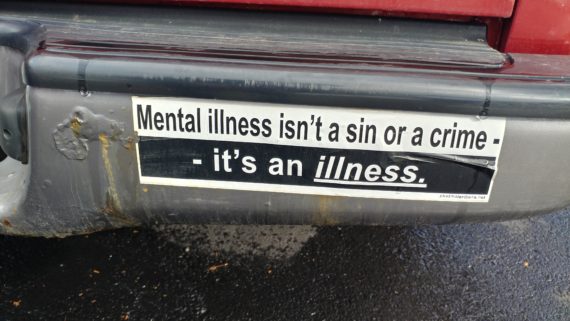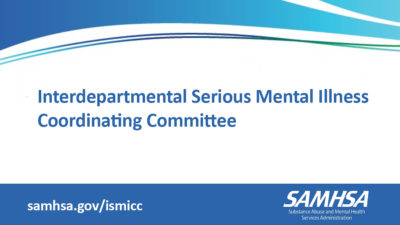
Bumper sticker on Pete’s old truck
(2-8-21) Let’s hope the Biden Administration takes advantage of a wonderful tool that could help the federal government better coordinate and prioritize its mental health programs.
The Interdepartmental Serious Mental Illness Coordinating Committee (ISMICC) was created in December 2016 by Congress to foster collaboration and shared accountability for the 8 federal agencies that deliver services to adults with serious mental illnesses (SMIs) and children and youth with serious emotional disturbances (SEDs) and their families.
Within a year, ISMICC’s first report was sent to Congress. Titled: The Way Forward: Federal Action for a System That Works for All People Living With SMI and SED and Their Families and Caregivers, the report offered 45 recommendations in five categories, that were drafted by ISMICC’s fourteen public members. As a parent representative on ISMICC, I focused on much needed criminal justice reforms.
Among the recommendations that I helped write:
- support implementation of the sequential intercept model that identifies key moments when incarcerated individuals with SMI and SED can get into treatment,
- support jail and prison diversion programs,
- train all first responders on how to work with individuals with SMI and SED,
- improve and streamline competency restoration services,
- support therapeutic justice dockets for SMI and SED individuals,
- require universal screening for SMIs and SEDs for every person booked into jail,
- limit or eliminate solitary confinement, seclusion, restraint and other forms of restrictive housing for SMI and SED prisoners,
- support post conviction recovery services,
- support federal programs created to reduce incarceration of SMI and SED Americans.
These are lofty, but achievable goals.
After that report was issued, my 13 public colleagues and I got right to work with the 15 representatives from the government agencies and departments that administer SMI and SED programs.
Dr. David Morrissette at SAMHSA (the government’s primary SMI and SED overseer) was put in charge of helping us implement our recommendations. Enthusiasm was high. You can read one of his blogs about ISMICC here. During one of our public meetings, ISMICC members broke into small work groups to discuss ways to implement the 45 recommendations. 
It was exciting and wonderful to be part of working groups with equally excited representatives from HUD, HHS, Labor, Defense, Social Security, Education, Veterans, and the Justice Department, all discussing how to better service Americans with SMIs and SEDs. I was especially thrilled when the federal Bureau of Prisons voluntarily joined ISMICC.
When Dr. Morissette retired in 2019, Dr. Anita Everett at SAMSHA took charge, helping the public members navigate the profusion of government red-tape that slows progress. ISMICC continued to move forward. With the exception of one public member, the rest of us participated in a monthly conference call to discuss new and the best treatment models, as well as how we could help our federal partners implement our recommendations.
Unfortunately, Dr. Everrett was assigned new duties and ISMICC moved to a back burner. Its twice a year mandatory meetings became pro-functional with point point presentations about the latest SAMHSA initiative rather than discussions about how to push forward with collaboration and our recommendations.
Shortly before the presidential elections, our terms on ISMICC ended. Along with three others, I was asked back but the remainder of my colleagues who worked so hard on the 45 recommendations were not. The newly appointed public members are impressive but they face a monumental task. By law, ISMICC has to issue its next report to Congress by December 2022. So far, SAMHSA has not taken any steps to encourage the original members, who wrote the first report, to speak with the newly appointed members who will be charged in just more than a year to write a final report.
A first step forward would be for SAMHSA to invite ISMICC’s original public members to participate in a meeting with its new members.
There’s still time to bring everyone up to speed and reinvigorate ISMICC, and that’s what should happen. We don’t need another mental health and substance abuse report gathering dust on a shelf somewhere.
What we need is action. What we need is collaboration. What we need is the still waiting-to-be-chosen Assistant Secretary for Mental Health and Substance Abuse to utilize ISMICC as Congress intended – as a tool to bring federal and public partners together.



